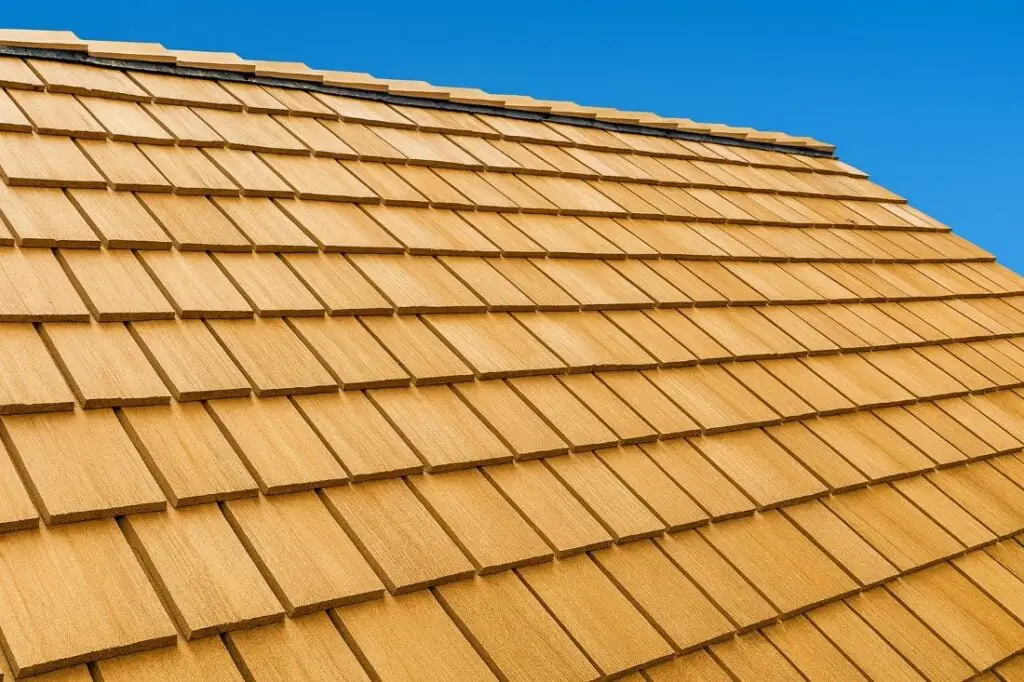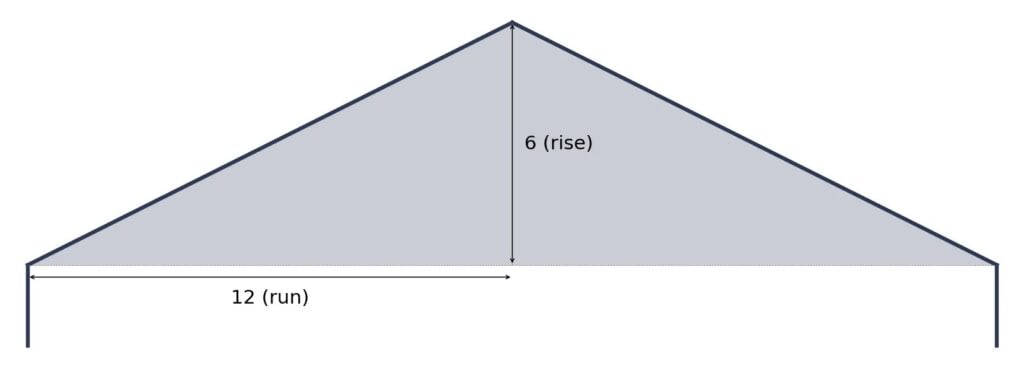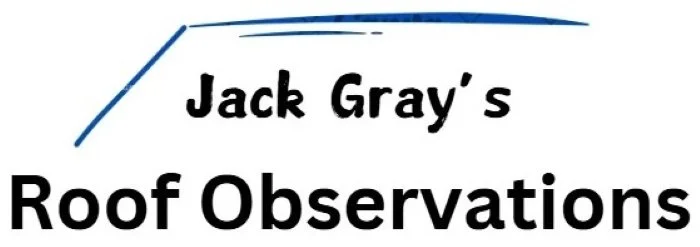I participate in the Amazon affiliate program and may earn commissions from purchases made through links on this page.
Table of Contents

Introduction
The slope of your roof affects how well it sheds rain, snow, and debris, and it determines what types of roofing materials are appropriate and are allowed by the building code. This article explains what the minimum roof pitch is for wood shingles and wood shakes (almost always made of cedar these days).
Note: Pitch and slope are not technically the same thing, but I’ll be using the terms interchangeably here. The building code uses “slope.”
Wood shingle and shake roofs are a water-shedding system. Unlike fully waterproof low-slope membranes, shingle and shake systems depend on gravity and the overlap between courses to keep water moving off the roof without penetrating the system. If installed on a roof that is too flat, wind-driven rain or snowmelt can get up under the shingles. This can lead to leaks, deck deterioration, and potentially mold. It also violates code, voids warranties, and can cost a lot to fix.
If you aren’t sure what your roof pitch is, you can get a very cheap, very accurate slope finder from Amazon. I have one of these and it works pretty well.
Minimum Allowed Roof Slope for Wood Shingles and Shakes
According to the International Residential Code (IRC) and the International Building Code (IBC), wood shingles can only be installed on roofs with a slope of 3-in-12 or greater. This means the roof must rise at least 3 inches for every 12 inches of horizontal run. A 3-in-12 slope can also be expressed as a 14° slope or a 25% slope. Anything less is a code violation and a very bad idea.
For wood shakes, there is a discrepancy between the IRC and the IBC. The IRC allows wood shakes to be installed on roofs with a slope of 3-in-12 or greater, but the IBC only allows wood shakes to be installed on slopes of 4-in-12 or greater. A 4-in-12 slope can also be expressed as a 18° slope or a 33% slope.


Installing cedar shingles or shakes on a roof with a slope below 3:12 can lead to serious problems. Because shingles are not watertight and rely on gravity to shed water, low-slope installations increase the risk of ice dam formation and water intrusion, especially during wind-driven rain or heavy snow/snowmelt. Installing them on a lower slope will almost certainly void the manufacturer’s warranty, fail inspection, and expose the homeowner to long-term damage and repair expenses.
And while a 3:12 pitch technically meets residential code, in practice it represents the bare minimum for these materials to function properly. Performance at that slope is not optimal. Wood shingles and shakes are best used on roofs with a slope of 5:12 or steeper, where water can drain quickly and the wood can dry out faster. In my professional experience, steeper roof slopes will extend the life of cedar roofs and reduce the likelihood of failure due to dry rot, snow, ice, or wind-driven rain.
If your roof pitch is below 4:12 or 5:12, especially in regions with heavy rainfall or snow, you may want to consider other materials designed specifically for low-slope applications, such as modified bitumen or standing seam metal. Choosing the right system for your roof pitch will save you from problems down the line.
Roofing Options for Roof Slopes Below 3:12
If your roof slope is less than 3:12, wood shingles or shakes are not allowed by code. And while asphalt shingles are allowed on roof pitches down to 2:12, and tile roofs can be installed on roofs as low as 2½-in-12, these are not optimal materials for such low slopes (from a performance standpoint). There are a few code-compliant alternatives specifically designed for low-slope conditions:
Metal Roofing (Standing Seam)
Standing seam metal roofing is one of the best-performing and best-looking options for low-slope residential roofs. The code allows it on slopes as low as ¼-in-12, provided the panel system is tested and approved for such applications. These panels interlock vertically and are secured with concealed fasteners, providing excellent resistance to rain, snow, and ice damming. Steel standing seam systems cost around the same as wood shingles or shakes, and they last longer than either.
Modified Bitumen
Modified bitumen (or “mod bit”) is somewhat similar to roll roofing, but much better. It consists of asphalt reinforced with plastic (APP) or synthetic rubber (SBS) to create a flexible, highly durable membrane. It can be installed on slopes as low as ¼-in-12. Modified bitumen is typically installed in two overlapping plies, forming a watertight barrier that can handle ponding and thermal movement. Like asphalt shingles, it’s typically surfaced with granules for UV protection and it comes in several colors.
Single-Ply Membranes (TPO, PVC, or EPDM)
If you’re thinking about installing a cedar roof, I doubt you’d be interested in using a single-ply membrane instead, simply because membrane roofs are utilitarian and would probably not be a good look for your house. But they are an option.
Single-ply membranes are common on commercial roofs, but they’re also suitable for low-slope residential roofs. Like other low-slope materials, they’re permitted on roofs as low as ¼-in-12. TPO and PVC are available in white, tan, and gray; EPDM is usually black. These membranes are lightweight, flexible, and watertight when properly installed. Just keep in mind that white membranes show dirt easily. That’s not an issue on commercial buildings, but it can be irritating if the roof area can be seen from decks or windows.
Code Sections: Minimum Roof Slope
From the 2024 International Residential Code, here are the sections that dictate acceptable roof slope for wood shingles and wood shakes:
Wood shingles shall be installed on slopes of 3 units vertical in 12 units horizontal (25-percent slope) or greater.
Wood shakes shall only be used on slopes of 3 units vertical in 12 units horizontal (25-percent slope) or greater.
And here are the equivalent sections from the 2024 International Building Code:
Wood shingles shall be installed on slopes of not less than 3 units vertical in 12 units horizontal (25-percent slope).
Wood shakes shall only be used on slopes of not less than 4 units vertical in 12 units horizontal (33-percent slope).
Underlayment Requirements
Here are the IRC underlayment requirements for wood shakes and shingle:
Underlayment Application – Wood Shakes and Wood Shingles (Table R905.1.1(2))
Areas Where Wind Design Is Not Required In Accordance With Figure R301.2.1.1:
Apply in accordance with the manufacturer’s installation instructions.
Areas Where Wind Design Is Required In Accordance With Figure R301.2.1.1:
Underlayment shall be one of the following:
1. Two layers of mechanically fastened underlayment applied in the following manner: Apply a strip of underlayment that is half the width of a full sheet parallel to and starting at the eaves, fastened sufficiently to hold in place. Starting at the eave, apply full width sheets of underlayment, overlapping successive sheets half the width of a full sheet plus 2 inches. End laps shall be 4 inches and shall be offset by 6 feet.
2. A minimum 4-inch-wide strip of self-adhering polymer modified bitumen underlayment complying with ASTM D1970, installed in accordance with the manufacturer’s installation instructions for the deck material, shall be applied over all joints in the roof decking. An approved underlayment complying with Table R905.1.1(1) for the applicable roof covering shall be applied over the entire roof over the 4-inch-wide membrane strips.
3. A single layer of self-adhering polymer modified bitumen underlayment complying with ASTM D1970, installed in accordance with the underlayment and roof covering manufacturer’s installation instructions for the deck material, roof ventilation configuration and climate exposure of the roof covering.
Note that the second part of this (Areas Where Wind Design Is Required) applies to geographic regions where buildings must be engineered to withstand higher wind forces due to increased risk of strong winds. These areas include designated hurricane-prone regions, coastal high-wind zones, and areas like mountain foothills and tornado-prone zones.
The language in the code means that the double underlayment requirement applies to all roofs, regardless of slope, in these areas. Increased roofing fastener requirements will normally also apply in these areas.

